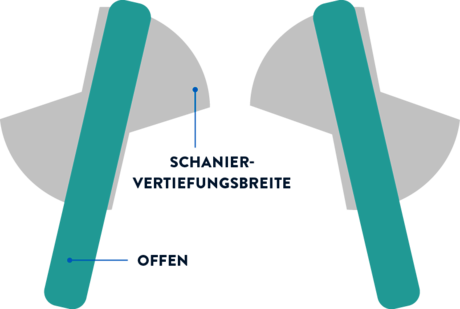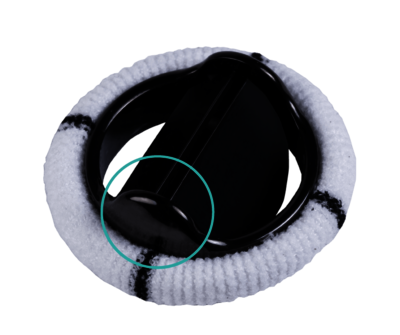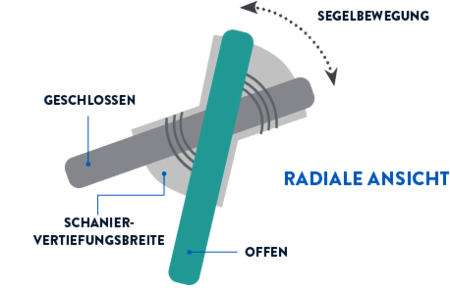Dank einzigartiger Konstruktionsmerkmale haben sich die mechanischen Herzklappen von Abbott - einschließlich der Regent™- und Masters-Serie - als Goldstandard für Zuverlässigkeit und Leistung etabliert, wobei die Komplikationsraten langfristig niedrig bleiben.
Die mechanischen Herzklappen von Abbott sind führend mit ihrem bewährten Bileaflet-Design, das zu einer geringen Thrombogenität und hervorragenden Patientenergebnissen führt.
- Die Klappenflügel öffnen sich in der Systole in einem Winkel von 85 Grad aufgrund ihrer stromaufwärts gerichteten Positionierung, die durch die einzigartigen Gelenkschutzvorrichtungen ermöglicht wird (siehe rechts).
- Starke, gleichmäßige Geschwindigkeiten innerhalb der Scharnieraussparungen unterstützen das Auswaschen von Blutelementen3
- Geringe Kohlenstoffoberfläche bedeutet weniger Thrombenbildung
- Das Verhältnis von Öffnung zu Kanüle (bis zu 84 %) sorgt für große effektive Öffnungsflächen (EOAs) und reduziert die Fehlanpassung zwischen Prothese und Patient4

DAS PIVOT GUARD DESIGN | EIN ABBOTT-MARKENZEICHEN
Der Pivot Guard, der in allen mechanischen Herzklappen von Abbott zum Einsatz kommt, bietet sowohl während der Implantation als auch nach der Implantation Vorteile
- Das vertiefte Design minimiert die Interaktion mit dem subannulären, nativen Mitralklappenapparat
- Die minimierte Kohlenstoffoberfläche kann die Bildung von Thromben verringern
- Pivot Guards helfen, den Pivot-Mechanismus vor Pannusbildung zu schützen
- Ermöglicht einen konsistenten Öffnungswinkel von 85 Grad, was ein minimales Flattern der Klappe und einen laminareren Fluss durch die Öffnung fördert5

GERINGE THROMBOGENITÄT | EINE NOTWENDIGKEIT BEI MHV ERSATZPRODUKTEN
Niedrige Thrombogenität steht bei der Entwicklung an erster Stelle
- Große Innendurchmesser von bis zu 26,1 mm fördern niedrige Druckgradienten6
- Niedrige Gradienten können dazu beitragen, die Scherbelastung und Thrombogenität zu minimieren7
- Gleichmäßige Geschwindigkeiten innerhalb der Scharnieraussparungen unterstützen die Auswaschung von Blutelementen3
- Das Abbott-Scharnierdesign ermöglicht eine vollständige Überlappung der Klappe, was die Auswaschung weiter unterstützt

- Internal Sales Tracking Spreadsheet. Data on file at Abbott.
- MHV Paper List. Data on file at Abbott.
- Jun BH, Saikrishnan N, Yoganathan AP. Micro particle image velocimetry measurements of steady diastolic leakage flow in the hinge of a St. Jude Medical Regent™ mechanical heart valve. Ann Biomed Eng. 2014;42(3):526-540. Published online 2013 Oct 2.doi: 10.1007/s10439-013- 0919-y
- Pibarot P, Dumesnil JG. Hemodynamic and clinical impact of prosthesis-patient mismatch in the aortic valve position and its prevention. J Am Coll Cardiol. 2000;36(4):1131-1141. doi.org/10.1016/s0735-1097(00)00859-7
- Shipkowitz T, Ambrus J, Kurk J, et al. Evaluation technique for bileaflet mechanical valves. J Heart Valve Dis. 2002;11(2):275-282.
- Internal Design Prints. Data on file at Abbott.
- Alemu Y, Bluestein D. Flow induced platelet activation and damage accumulation in a mechanical heart valve: numerical studies. Artif Organs. 2007;31(9):677-688. doi: 10.1111/j.1525-1594.2007.00446.x.
- Gammie JS, Chikwe J, Badhwar V, et al. Isolated mitral valve surgery: The Society of Thoracic Surgeons Adult Cardiac Surgery Database analysis. Ann Thorac Surg. 2018;106(3):716-727.
- Satter Y, Rauf H, Bareeqa S, et al. Transcatheter aortic valve replacement versus surgical aortic valve replacement: A review of aortic stenosis management. Cureus. 2019;11(12):e6431. doi: 10.7759/cureus.6431
- Nishimura RA. 2017 AHA/ACC focused update of the 2014 AHA/ACC guideline for the management of patients with valvular heart disease: A report of the American College of Cardiology/American Heart Association Task Force on Clinical Practice Guidelines. Circulation. 2017;136(9):1-123.
- Ren X. Aortic stenosis. Medscape. emedicine.medscape.com/article/150638-overview. Updated May 7, 2019.
- Dziadzko V, Clavel MA, Dziadzko M, et al. Outcome and undertreatment of mitral regurgitation: A community cohort study. Lancet. 2018;391(10124): 960-969.
- Regent Instructions for Use.
- Regent PMA Supplement.
- Okamura H, Yamaguchi A, Morita H, et al. Is the threshold for postoperative prosthesis-patient mismatch the same for all prostheses? Surg Today. 2013;43:871-876.
- Masters Series Instructions for Use.
- Baumgartner H, et al. 2017 ESC/EACTS Guidelines for the management of valvular heart disease: The Task Force for the Management of Valvular Heart Disease of the European Society of Cardiology (ESC) and the European Association for Cardio-Thoracic Surgery (EACTS). Eur Heart J. 2017;38(21):2739-2791.




